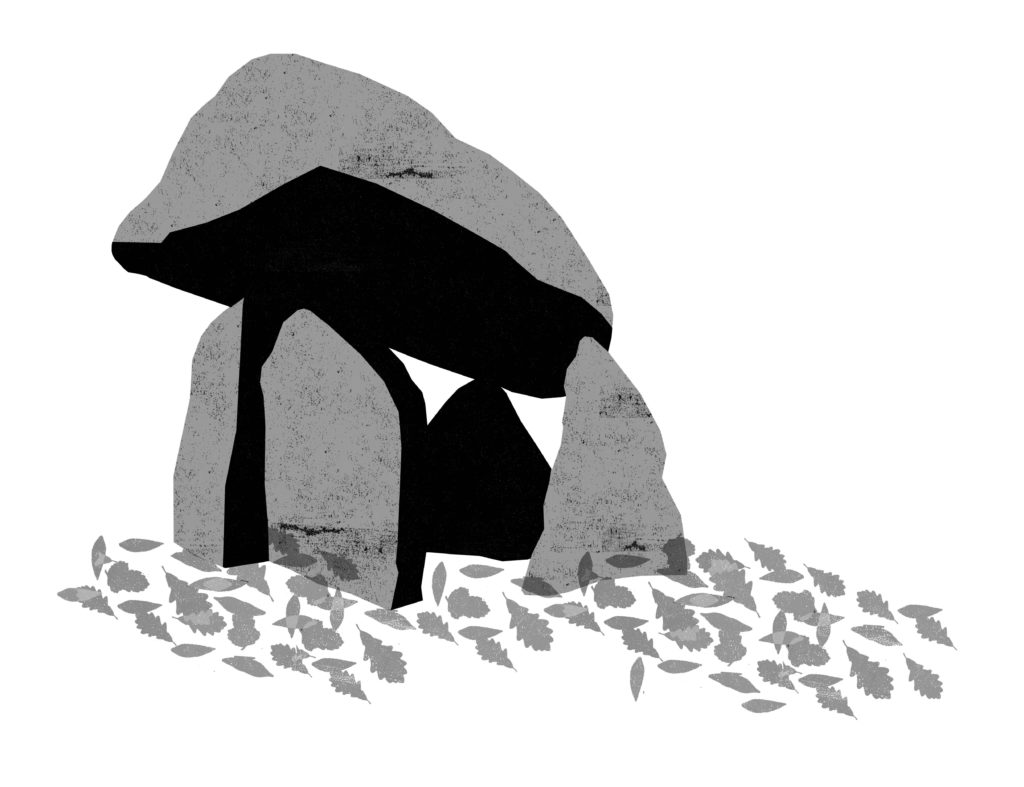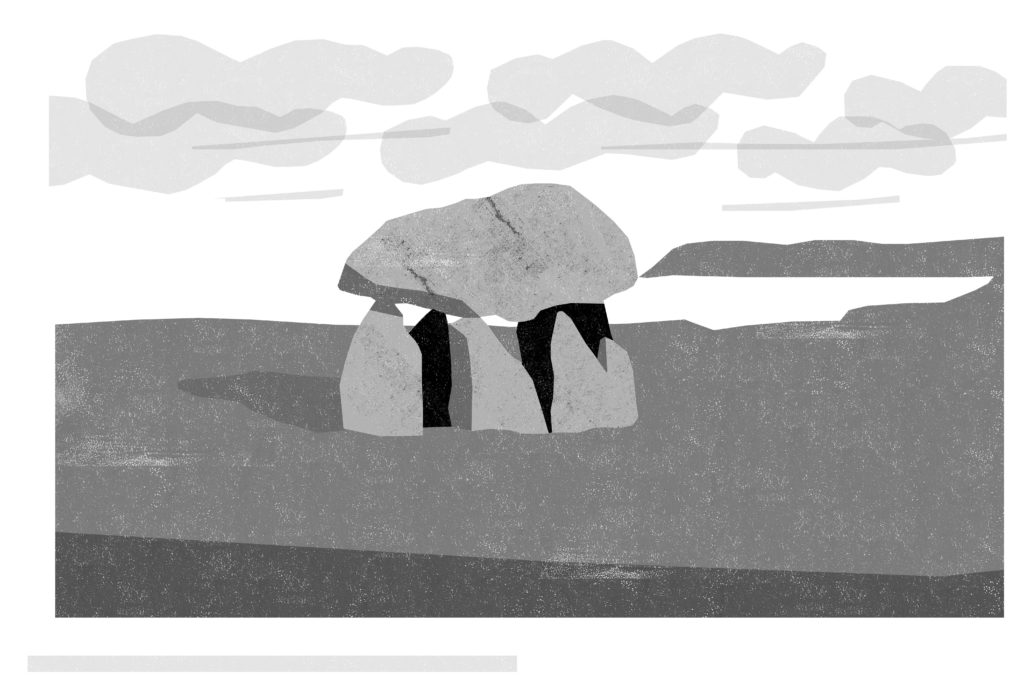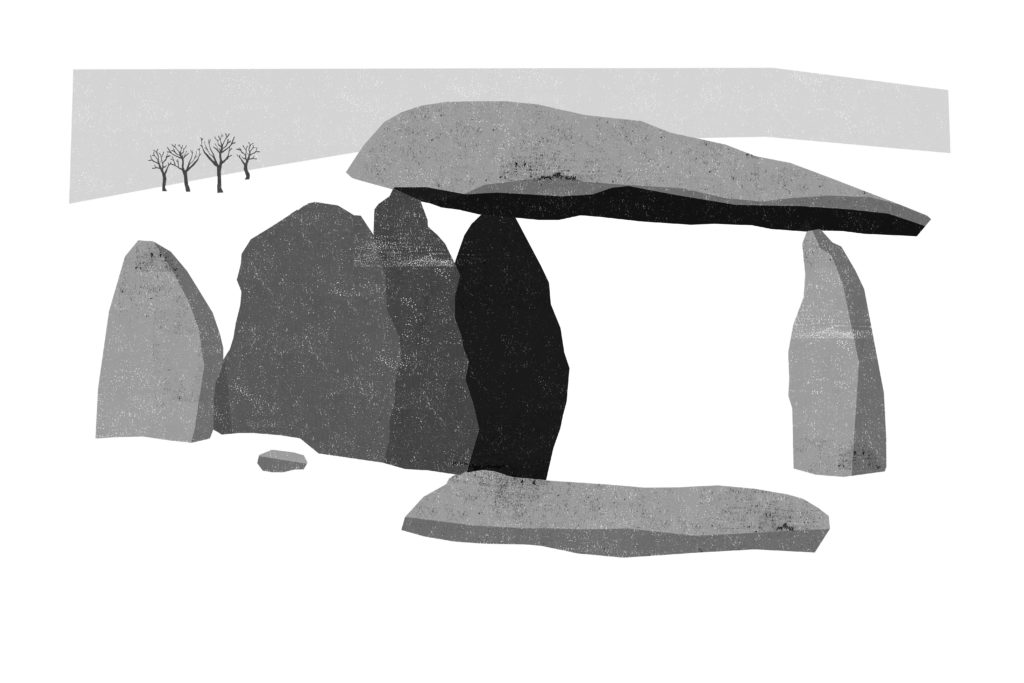Jeb Loy Nichols and Rhys Mwyn venture out in search of mysterious megaliths

This afternoon I’ll sit alone, eating a late lunch on the porch, watching the newly dug pond. I’m still getting used to it. My eyes will follow the torn and rubbled earth, watching the dimming places where dirt meets water, where one day small animals will slide into the waiting wet. I’ll watch the bugs that have already appeared. My meal will be simple; rice and minted peas, mushrooms and grated carrots. The night will be cool without being cold. The surface of the water will pitch and shift; the grass will bend. There will be, reflected in the uneven surface, the faint clouds that have drifted in from the coast.
I’ll be older tomorrow. Hungry in a fresh way. I’ll watch stuff until I find something new to admire.
I’m driving south with my good buddy Rhys Mwyn looking for standing stones. The day is grey and damp and nearly but not quite raining. We’re mostly talking about music, about punk and its aftermath, about southern soul, about Memphis and London and Cardiff and Snowdonia. Rhys is an archeologist and he’s writing the third book in his series about the ancient sites of Wales. I’m along to keep him company and provide some illustrations.
I’ve never thought too deeply about standing stones. I’ve seen pictures of them, driven past them, read about them in books. I know what they are. I don’t know why they are or when or where or who put them there or what they might mean.
As we drive the back roads through the uncrowded Welsh hills, I’m thinking that in a hundred years, in two hundred years, in five or six generations, this road will be long gone. A slight crease through a wood. Not a human within a hundred miles. Everything returned to the winged and the furred and the leafed. Quiet again and not quiet. A home to large cats and newts and spiders and uncut oaks. A home to moss and lichen and fungal molds. I’ll be out before the worst happens. Or the best, depending on your point of view. It won’t be long. The roads will crack and heave apart and be folded back into the earth. A great reclaiming will occur. Chicken farms and wind turbines and canals and bus shelters, all rubbled. Priests and stockbrokers gone. All sheep and cattle and hill farmers gone. It’ll take time. Things will alter. All talking will be less. Books and songs and poems gone. Instead barking and strange baying and the constant slap of water. Take away Chinese? Gone. Condiments in tiny plastic pouches? Gone. Facial piercings? Gone. Your dog? Gone. White weddings? Gone. Assisted living? Gone. Shoes made from reptiles? Gone. Volkswagens? Your mother? The fifth floor? Your job? Fruit syrup? Weekends in Paris? All gone.

The stones, when we find them, unnerve me. They seem to exist as all truly great things do, outside time, outside commerce, outside reason, outside commodity. They cannot be figured out. They cannot be reasoned with. They cannot be made simple. They’re not for us, not for our use. We have forfeited all connection to them. We live in a world of cheap violences; a world unentangled with magic, a world that has nothing to gain from them. They are, now, simply piles of rocks in a field, visited by the marginal, the bookish, the romantic. Rocks that aren’t sellable; that are unexplainable and unburiable. A liminal life that has no definite beginning, no frame of reference, no modern resonances. That do no one any good.
In this way we live amongst the ghosts of what we ignore.
Books have been written about how the stones were moved, how they were constructed; the feats of engineering required to heave such massive rocks into place. I have a feeling, standing amongst the standing stones, that the academics have gotten it wrong. There were no heroic struggles, no marshalling of entire villages, no levers and catapults. There were no rollers or wheels or fire hardened rods. There was only magic. If the people that put these structures in place had a different relationship to the natural world, it’s likely that they had a different relationship to the unnatural world as well. Knowledge gets lost. Those things important to one generation lose their way to the next. If we’ve seen it happen over the past 100 years, imagine the knowledge lost over the past three thousand.
I’m looking at LLech Y Trybedd and this is what I’m thinking: it’s impossible to have placed that massive slab of granite in such a delicate position without the help of magic. I’m picturing the stone being manipulated by a single person, a person in possession of knowledge unthinkable to us. The stone is raised, rotated, dipped and positioned, floated down and made secure with the help of a single finger. The owner of that finger, the finger that temporarily suspends gravity, is a much respected member of the community. The keeping of this knowledge is his or her job. It’s what they do. It’s something they’ve learned, something they’ve been taught. Something that, a thousand years later, their children will forget.

Nothing is what it seems to be and neither is it the opposite.
I read that somewhere.
I’m standing in the wet grass and I’m wondering if I know anything about anything.
Be Realistic – Demand The Impossible!
So chanted the French students in 1968.
What I’m thinking is: I don’t know what the stones mean or how they got here or how old they are or what they say about us. I only know that they’re here. A reminder of what I don’t know, of what I’m not, of what I’ll never be, of what I don’t want or need. They are, to me, Monuments of Reluctance. In no hurry to give up their secrets, to join the flow of modern life. They are against logic, against everything we’ve been taught. They are against what we’ve become. They sit silently. Outside. Apart. They are impossible.

On the way home I’m talking to Rhys and I’m looking up at the moon. The moon, I feel, is not to be discussed, nor described, nor desired, nor annexed. It is to be left alone. Left alone to be distant. We can, if we must, look at it. It can bare our eyes. But only that. There it ends. Who are we to examine it, to prod it, to steal from it, to humanize it. To use it.
My mind wanders back to LLech Y Trybedd: it needs no explanation, no system of belief. It neither bleeds nor talks. It sits. It absorbs the sun, the rain, the snow, the wind. It gives no comfort. It is what it’s become. It’s not what it seems to be and neither is it the opposite.
The point of standing stones is that they stand. They do nothing else. They neither sing nor dance nor consume nor create. They stand. While we pursue all our hectic doings. We accumulate and plan and build empires, we tell stories, we protest, we accomplish. We impress ourselves. While they stand. Moss comes and grass comes and weather comes and people come. While they stand.
They do this one, silent, unruffled thing.
They stand.
*
Rhys Mwyn’s books can be found here.
June is Short, July is Long, the upcoming album from Jeb Loy Nichols and the Westwood All-Stars, is available for pre-order here.
Jeb will perform on Rhys’s stage at this year’s Good Life Experience. You can see our stage lineup here.